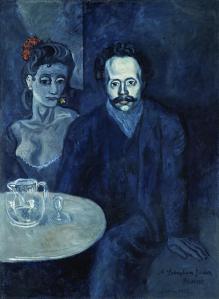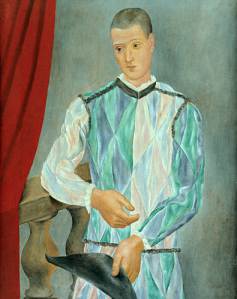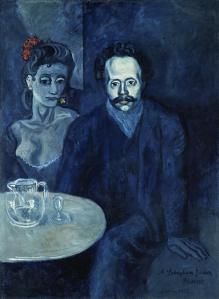LACMA recently loaned its prized painting Portrait of Sebastia Juñer Vidal (1903) by Pablo Picasso to the Sterling and Francine Clark Art Institute in Williamstown, Massachusetts, and the Museu Picasso in Barcelona for their groundbreaking exhibition Picasso Looks at Degas. Not wanting the galleries to be without an example of Picasso’s figural portraiture, the curators have arranged for the Museu Picasso’s Harlequin (1917) to be on view in LACMA’s modern art galleries through the end of January 2011. This painting affords us the rare opportunity to see firsthand Picasso’s return to a neoclassical style after the advent of cubism.

Pablo Picasso, Portrait of Sebastia Juñer Vidal, 1903, oil on canvas, David E. Bright Bequest, © Estate of Pablo Picasso / Artists Rights Society (ARS), New York
Portrait of Sebastia Juñer Vidal represents the artist’s famed Blue Period, where his tragic blue palette and his portraits of outcasts display a palpable loneliness often present in his work. Although in the Rose Period his eerie blues gave way to flesh-toned pinks, Picasso consistently portrayed figures haunted by an inescapable solitude. He gravitated towards harlequins, dancers and singers whose jobs are to entertain the public yet find no solace in it. After living for several years in Paris, at which time he and Georges Braque developed cubism, Picasso in 1917 moved back to Barcelona for a short time; the dominating neoclassical art scene inspired the artist to revisit figural representation.

Pablo Picasso, Harlequin, 1917, oil on canvas, Museu Picasso, Barcelona, © Estate of Pablo Picasso / Artists Rights Society (ARS), New York
In Harlequin, a ballet dancer in full costume stands upon a stage, his downcast gaze communicating his isolation. The flatness of the dancer’s costume, emphasized by its geometric pattern, contrasts with the weight and volume of his hands, and its monotone background conflicts with the depth achieved by the curtain. Thus, this rare painting stands as a unique amalgamation between the subject matter of the blue and rose periods and the play with perspective and illusionism found in his cubist works.
The painting holds particular importance for the city of Barcelona as it was the first work by Picasso to enter the city’s museum collections. Its installation at LACMA allows viewers to see a pivotal moment in Barcelona’s history as well as in Picasso’s development into one of the most important and influential modern artists.
Lauren Bergman, Curatorial Assistant, Modern Art



